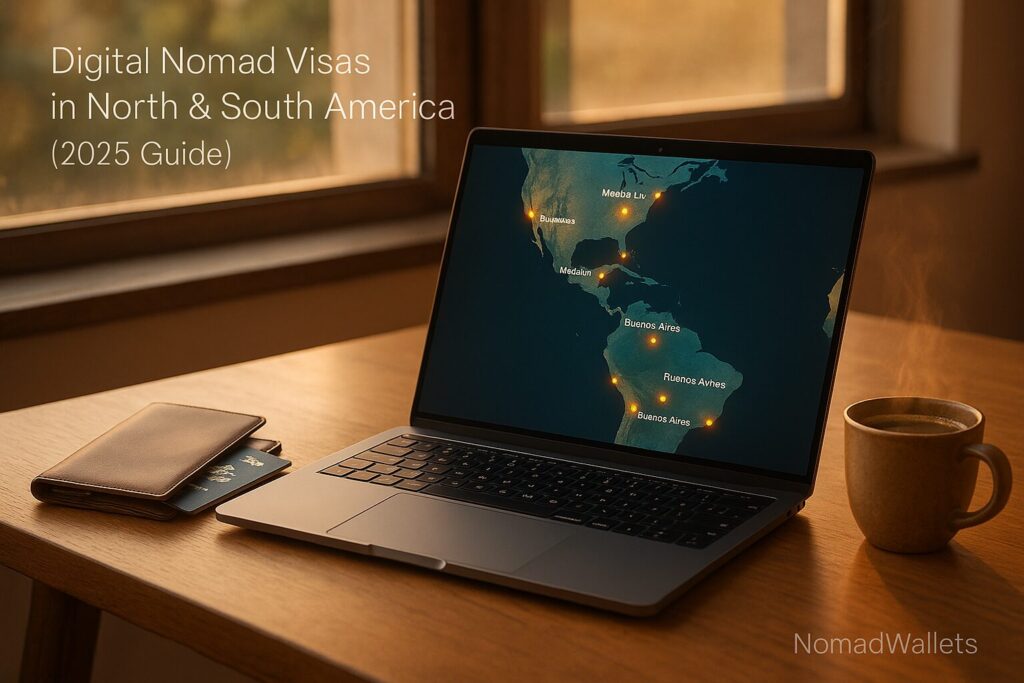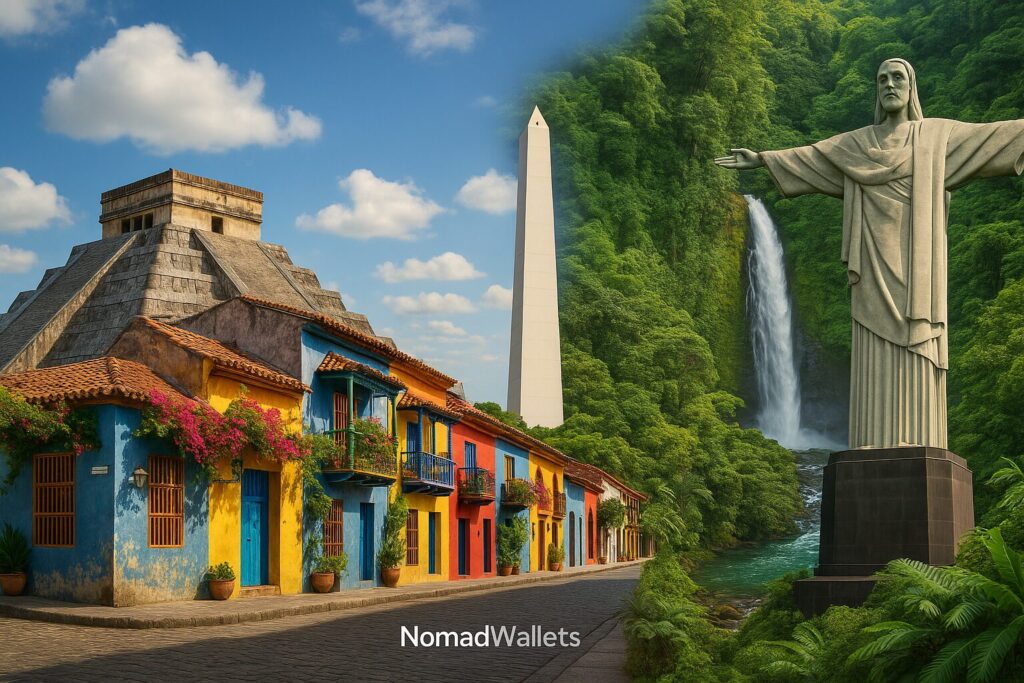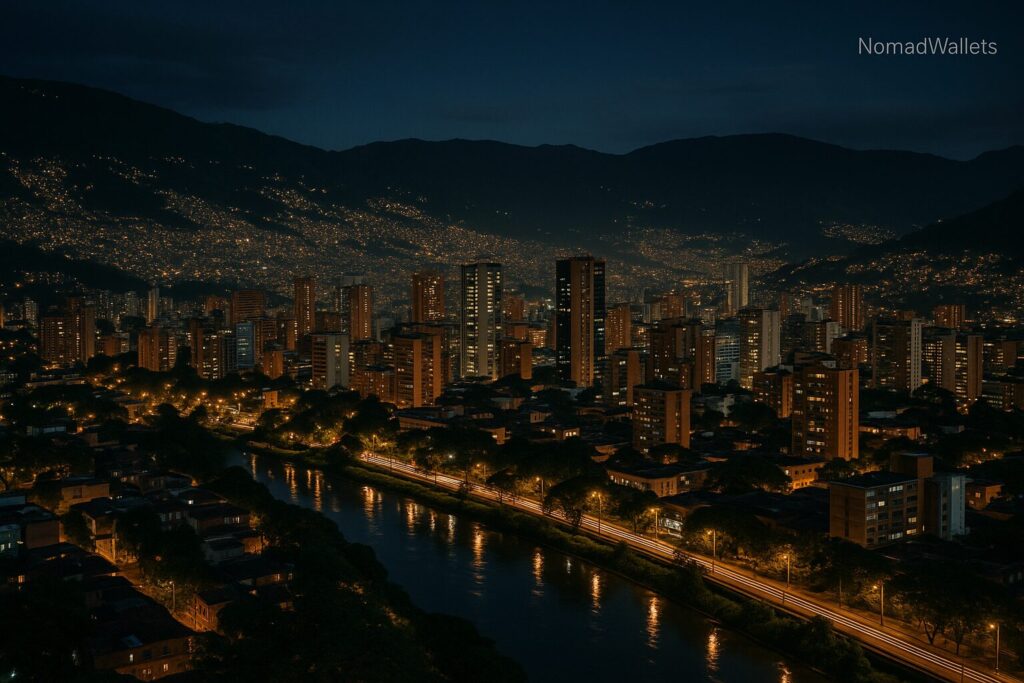
So… Why Is Everyone Heading to the Americas?
Let’s be real — the Americas (especially Latin America) are booming for remote workers right now.
And no, it’s not just about the tacos (though those help).
It’s about the mix: affordable cost of living, decent internet in major cities, vibrant culture, easy time zones if you’re working with U.S. clients, and now… official digital nomad visas.
In 2025, more countries across North and South America are jumping on board — creating programs that let you stay longer without border runs, sketchy paperwork, or overstaying tourist visas. These Digital Nomad Visas in America 2025 are still new, still evolving, and sometimes a little vague — but they exist. And that’s huge.

Countries Offering Digital Nomad Visas in the Americas
Here’s what’s currently on the table (with a few notes based on what real nomads are experiencing in 2025):
🇲🇽 Mexico — The “Unofficial Official” Visa Route
- Visa Name: Temporary Resident Visa (used by most nomads)
- Length: 1 year (renewable up to 4)
- Income Requirement: ~$2,600/month (or savings of ~$43,000)
- Perk: Simple process, and you can technically work remotely as long as you’re not taking local jobs
📍 Where Nomads Go: Mexico City, Oaxaca, Playa del Carmen
🇨🇴 Colombia — Affordable, Chill, and Nomad-Ready
- Visa Name: Digital Nomad Visa (V Visa)
- Length: 2 years
- Income Requirement: ~$684/month (yes, really!)
- Perk: One of the lowest financial requirements out there
📍 Where Nomads Go: Medellín, Bogotá, Cartagena
🇦🇷 Argentina — Not Official, But Possible
- Visa Name: None yet — but tourist stays are long (90–180 days) and extendable
- Length: 3–6 months
- Income Requirement: Not strict, but proof of funds helps
- Perk: Unbeatable affordability — Argentina is still incredibly cheap for nomads
📍 Where Nomads Go: Buenos Aires, Mendoza, Cordoba
🇨🇷 Costa Rica — A Laid-Back Option with Jungle Vibes
- Visa Name: Rentista or Remote Worker Visa
- Length: 1 year (renewable)
- Income Requirement: ~$3,000/month
- Perk: Beautiful landscapes + community of conscious travelers
📍 Where Nomads Go: San José, Santa Teresa, Tamarindo
🇧🇷 Brazil — Big Country, Big Opportunity
- Visa Name: Digital Nomad Visa
- Length: 1 year (renewable)
- Income Requirement: ~$1,500/month OR bank savings of $18,000
- Perk: Stunning cities, beaches, and very warm people
📍 Where Nomads Go: São Paulo, Florianópolis, Rio de Janeiro
Visa Comparison Table (Quick Look)
| Country | Min. Income / Month | Duration | Renewable | Notes |
| Mexico | $2,600 | 1 year | ✅ | Widely used, not a “real” nomad visa |
| Colombia | $684 | 2 years | ✅ | Super budget-friendly |
| Argentina | N/A (Tourist visa) | 3–6 months | ❌ | Easy entry, no official visa yet |
| Costa Rica | $3,000 | 1 year | ✅ | Nature + good remote vibe |
| Brazil | $1,500 | 1 year | ✅ | Relaxed but requires paperwork |

Tips for Digital Nomads in the Americas (Lessons from the Road)
If you’re planning to live the digital nomad dream somewhere between Mexico and Argentina, buckle up — it’s mostly amazing, but there are a few curveballs.
Here’s what I’ve picked up after spending time across Latin America with just a laptop and a carry-on.
Spanish Is Not Optional (Well, Kind Of)
Yes, you can survive in big cities without speaking much Spanish. But that doesn’t mean you should.
Even knowing how to say things like “Wi-Fi is not working” or “Where can I get a SIM card?” will save you hours of frustration. Locals usually appreciate the effort, even if you butcher the grammar.
The moment it really hit me? I was trying to explain to a pharmacist in Buenos Aires that I had a headache and ended up miming “brain explosion.” She laughed, gave me aspirin, and asked if I was a YouTuber.
Duolingo helps, but real-world practice is the best teacher. Just speak — even if it sounds awkward.
Safety Is Mostly Common Sense
Latin America gets a bad rap for safety, but honestly, if you act like a local (not a lost tourist), you’ll be fine in most places.
Here’s the routine that’s worked for me:
- Don’t flash your iPhone in crowded markets.
- Use Uber or Bolt at night.
- Know which neighborhoods are chill and which to skip (ask locals or expats).
- Carry a dummy wallet with a few bucks — just in case.
Also: watch out for pickpockets in public transport, and keep your laptop bag in sight always. Sounds obvious, but you’d be surprised.
Visas Can Be Confusing — Keep Everything Digital
Every country has its own rules. Some want bank statements, others want health insurance, some even ask for rental contracts before you arrive.
Best thing I ever did? Created a folder in Google Drive called “Nomad Docs.” Inside it: scanned passport, bank statements, medical insurance, vaccination cards, and even a couple of random passport-size photos (you’d be surprised how many places still ask for these).
Also: bring a couple of printed copies with you, just in case you land somewhere old-school.
Find Your People — It’ll Save Your Sanity
Every city I’ve been to — Medellín, Mexico City, even Cusco — has some kind of digital nomad or expat group. Join it.
Not just for the tips, but because loneliness sneaks up on you if you’re solo. A quick coffee meetup or coworking day with other nomads can totally change your week.
And let’s be honest: it’s also where you’ll hear about the best tacos, hidden cafés with decent Wi-Fi, and which immigration office to avoid like the plague.

Best Cities in the Americas for Digital Nomads
Once you’re visa-ready, the next question is: Where should I actually live? Here are a few nomad favorites — each with its own vibe:
🏙️ Medellín, Colombia
With year-round spring weather, cheap rent, and buzzing coworking cafés, it’s no surprise Medellín is a Latin American nomad hotspot. El Poblado and Laureles are packed with remote workers sipping coffee and taking Zoom calls in Spanish-tile cafés.
🌮 Mexico City, Mexico
One of the best all-rounders. Fast internet, walkable neighborhoods (like Roma and Condesa), amazing food, and tons of remote workers. Plus, it’s easy to fly in and out of. Just be ready for altitude and traffic.
💃 Buenos Aires, Argentina
Tango, steak, and beautiful old architecture — but also surprisingly modern for remote workers. Buenos Aires gives you a European vibe on a budget, especially if you earn in dollars. Plus, locals are super friendly and often happy to practice English.
🏖️ Florianópolis, Brazil
Imagine finishing work and walking five minutes to the beach. “Floripa” blends island life with just enough tech infrastructure to make working remotely easy (most of the time). Think flip-flops, açai bowls, and hammock breaks.
🌴 Santa Teresa, Costa Rica
It’s tiny, remote, and full of nomads who wanted to unplug just a little. Wi-Fi might be spotty, but if you’re craving surf sessions between client calls and dinners barefoot on the sand, Santa Teresa might be your place.
These cities offer a great launchpad — especially if you’re looking to travel slowly, build community, and maybe even stay long enough to call it home.
Want more city ideas? Check out our full list of Top 25 Digital Nomad Cities for 2025.
FAQs :- Digital Nomad Visas in America
Q1. Can I just use a tourist visa to work remotely?
Technically, no — but many people do. It depends on your risk tolerance. A digital nomad visa gives you peace of mind and avoids legal gray areas.
Q2. How long does it take to get approved?
Depends. Colombia can take a few weeks. Mexico can take a few months. Each country has its own timeline (and chaos).
Q3. Do I need to prove I have a remote job?
Usually, yes. You’ll often need client contracts, proof of income, or a letter from your employer stating you can work remotely.
Q4. What happens if I overstay?
Fines, possible bans, headaches at the airport. Don’t risk it.
Conclusion + Next Steps
The Americas — especially Latin America — are ripe for remote workers in 2025. With affordable cities, beautiful cultures, and growing digital nomad visa programs, it’s the perfect place to work, travel, and live differently.
Want to get started?
👉 Need help choosing your first stop? Check out our guide: 25 Solo Travel Destinations for Digital Nomads
👉 Not sure how to land remote work? Here’s our step-by-step guide to remote jobs in 2025
👉 Worried about insurance? We’ve got you covered — read: Complete Travel Insurance Guide for Nomads
Tags :- #DigitalNomadVisas #DigitalNomadVisas2025 #NomadVisas #RemoteWork #RemoteWork2025 #NomadLife #DigitalNomadLifestyle #WorkFromAnywhere #NomadWallets #TravelAndWork #NomadTips #AmericasNomads #LatinAmericaNomads #NorthAmericaNomads #SouthAmericaNomads #WorkAbroad
Hi, I’m Tushar a digital nomad and the founder of NomadWallets.com. After years of working remotely and traveling across Asia and Europe, I started NomadWallets to help U.S. nomads confidently manage money, travel, banking, crypto, and taxes. My mission is to make complex financial topics simple, so you can focus on exploring the world and building true location freedom.
